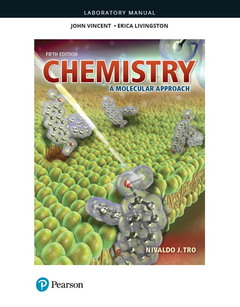Description
Laboratory Manual for Chemistry (5th Ed.)
A Molecular Approach
Author: Tro Nivaldo
Language: English
Subject for Laboratory Manual for Chemistry:
416 p. · 23.4x27.6 cm · Paperback
Description
/li>Contents
/li>Biography
/li>Comment
/li>
For courses in Chemistry Laboratory.
With a focus on real-world applications and a conversational tone, this laboratory manual contains experiments written specifically to correspond with Chemistry: A Molecular Approach, 5th Edition by Nivaldo J. Tro. Each experiment covers one or more topics discussed within a chapter of the textbook, with the dual goal of 1) helping students understand the underlying concepts covered in the lecture, and 2) presenting this material in a way that is interesting and exciting.
Updated for the new edition of Chemistry: A Molecular Approach, this manual contains twenty-nine experiments with a focus on real world applications. Each experiment contains a set of pre-laboratory questions, an introduction, a step-by-step procedure (including safety information and a report section featuring post-laboratory questions). Additional features include a section on laboratory safety rules, an overview on general techniques and equipment, as well as a detailed tutorial on graphing data in Excel.
Table of Contents
- General Laboratory and Safety Rules
- General Laboratory Equipment and Procedures
- Graphing Data Using Excel®
- Experiments
- 1. Laboratory Basics: Accuracy and Precision–Who’s the Shooting Champion?
- 2. Components of a Mixture–What Is That Stuff in the Bottom of the Cereal Box?
- 3. Cathode Ray Tubes, Millikin Oil Drop, and Avogadro’s Number
- 4. Conservation of Mass and Reaction Types: Copper Recovery Cycle
- 5. Equivalent Weights and the Periodic Table
- 6. Hydrates
- 7. Gas Laws
- 8. StyrofoamTMCup Calorimetry: Atomic Weights
- 9. Chemiluminescence: Glow Stick in a Beaker
- 10. Atomic Spectra
- 11. Reactivity of Group 1 Metals: Yes, Mom, I Threw Sodium into Water in Class Today, Optional: Determining the Amount of Alkali Metals Used
- 12. Flame Tests: Flames and Smoke Bombs
- 13. VSEPR and Molecular Models
- 14. Simulating the Shroud of Turin: An Inquiry-Based Experiment
- 15A. Observe the Rainbow: Paper Chromatography
- 15B. Chemical Oil Dispersants
- 16. Sublimation
- 17. Closest Packed Structures
- 18. Colligative Properties: Freezing Point Depression
- 19A. Diet Coke® and Mentos®: An Inquiry-Based Experiment
- 19B. Kinetics: Testing for Semen–Acid Phosphatase
- 19C. Kinetics: Activation Energy
- 20. Equilibrium Constant and Le Châtelier’s Principle: CoCl2
- 21. Far from Equilibrium: Creating Life in a Beaker
- 22. Acid—Base Titration
- 23. Determining the Buffer Capacity of Antacids
- 24. Entropy: The Chelate Effect
- 25. Redox Reactions: Detecting Traces of Blood
- 26. Radioactivity
- 27. Qualitative Analysis
- 27A. Group I Cations
- 27B. Group II Cations: “I Love the Smell of Hydrogen Sulfide–It Smells Like Victory”
- 27C. Piltdown Man and Scientific Ethics
- 27D. Group IV Cations
- 27E. Anions
About our author
Nivaldo Tro has been teaching college Chemistry since 1990 and is currently teaching at Santa Barbara Community College. He received his Ph.D. in chemistry from Stanford University for work on developing and using optical techniques to study the adsorption and desorption of molecules to and from surfaces in ultrahigh vacuum. He then went on to the University of California at Berkeley, where he did postdoctoral research on ultrafast reaction dynamics in solution. Professor Tro has been awarded grants from the American Chemical Society Petroleum Research Fund, the Research Corporation, and the National Science Foundation to study the dynamics of various processes occurring in thin adlayer films adsorbed on dielectric surfaces. Professor Tro lives in Santa Barbara with his wife, Ann, and their four children, Michael, Ali, Kyle, and Kaden. In his leisure time, Professor Tro enjoys mountain biking, surfing, and being outdoors with his family.
Hallmark features of this title
- Concept-oriented experiments provide varying levels of guidance from and “inquiry-based” appraoch to a classical “cookbook” approach.
- Experiment approaches range from traditional to open-ended and inquiry driven.
- Experiments that general chemistry students rarely perform have been designed to be conducted in a careful, controlled fashion.




